Blastomycosis Market Research, 2031
The global blastomycosis market size was valued at $177.2 million in 2021 and is projected to reach $257.7 million by 2031, growing at a CAGR of 3.8% from 2022 to 2031. Blastomycosis is a fungal infection caused by the organism Blastomyces dermatitidis. Blastomyces dermatitidis grows in wood and soil. When inhaled, the spores of Blastomyces enter into the body through the air, primarily affecting the lungs and causing pneumonia. After that, fungi spread to other body parts through the bloodstream. Blastomycosis can affect any host, however, it is more severe in people with impaired immune systems. The two most severe side effects of blastomycosis are central nervous system involvement and acute respiratory distress syndrome.
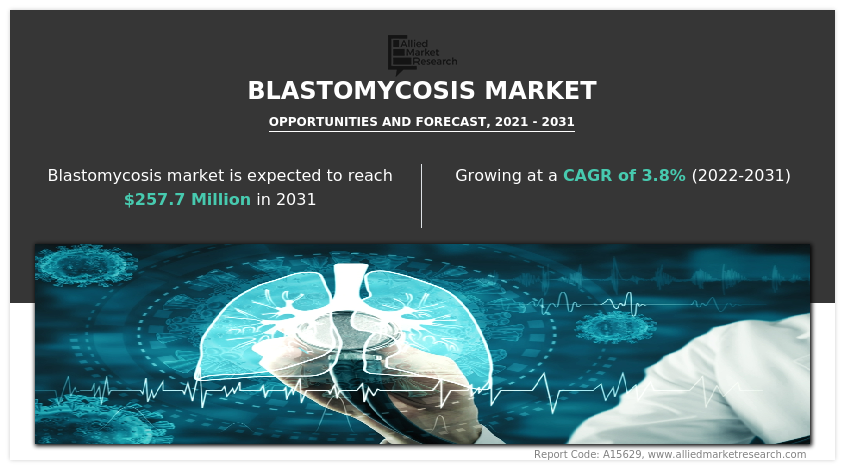
Drugs such as azole, allylamines, echinocandins, and polyenes are used for the treatment of blastomycosis. These drugs are used in the form of tablets, ointment, powder, and liquid as per the status of blastomycosis disease and the condition of blastomycosis patients. The blastomycosis market size has witnessed growth, owing to a rise in the prevalence of fungal infection, an increase in immunological diseases such as human immunodeficiency virus (HIV), Acquired Immune Deficiency Syndrome (AIDS), tuberculosis, pneumonia, a rise in a number of hematological cancers, and surge in demand for amphotericin B therapy. Hence, all such factors boost the growth of the blastomycosis market share.
For instance, according to the Centers for Disease Control and Prevention, blastomycosis is an opportunistic infection that happens when a person’s immune system is weakened. These illnesses can be caused by bacteria, viruses, or fungi. Many fungal infections are opportunistic infections. For instance, according to the World Health Organization (WHO), in 2020, Africa displays a higher prevalence of HIV, with an estimated average of 3.9% (anywhere from 3.3-4.5%) of the population living with HIV. According to WHO, 7,800,000 HIV cases were reported in 2020. Therefore, such a rise in immunological diseases has propelled the growth of the blastomycosis market. In addition, the rise in the use of combination therapy of anti-fungal drugs for reducing the emergence of drug-resistant blastomycosis fungal infection, and prevention from relapse of fungal infection drive the growth of the blastomycosis market.
For instance, according to the review article “Pharmacology and Pharmacodynamics of Antifungal Agents” published in January 2020, amphotericin B and flucytosine have both been shown to have a safe and higher potency effect against fungal infection.
Moreover, a rise in diagnostic procedures such as biopsies to detect fungal infection, an increase in bone marrow & organ transplantation procedures, a surge in the trend of camping in forests, and favorable government funds to combat antifungal diseases boost the growth of the blastomycosis market. However, unfavorable reimbursements as well as complications such as growth in population with antifungal drug resistance, the presence of counterfeit drugs, and side effects of blastomycosis drugs are expected to hamper the market growth. On the contrary, unmet medical demands in developing countries and lucrative opportunities in emerging economies are expected to create immense opportunities for blastomycosis manufacturers worldwide in the future.
In addition, technological advancements; the launch of various products, and strategies among key players such as acquisition, collaboration, and agreement drive the growth of the blastomycosis market. For instance, in June 2021, Celon Laboratories Pvt. Ltd. announced the launch of AM FIGHT, an amphotericin B emulsion, used in the treatment of fungal infection. The emulsion-based formulation is an ideal alternative to Liposomal Amphotericin B to combat the Black Fungus. The launch of AM FIGHT helped the company to strengthen its anti-fungal product portfolio. This type of product launch boosts the growth of the blastomycosis market
Blastomycosis market segmentation
The blastomycosis market is segmented on the basis of formulation, drug type, distribution channel, and region. On the basis of formulation, the market is classified into tablets, ointment, powder, and liquid. On the basis of drug type, the market is classified into azoles, polyenes, and others. Depending on the distribution channel, it is fragmented into hospital & clinical pharmacy, online pharmacy, and retail pharmacy.
Region-wise, the market is analyzed across North America (the U.S., Canada, and Mexico), Europe (Germany, France, the UK, Italy, Spain, and the rest of Europe), Asia-Pacific (China, Australia, India, South Korea, and rest of Asia-Pacific), and LAMEA (Brazil, South Africa, Saudi Arabia, and rest of LAMEA).
By Formulation Segment Review
On the basis of formulation, the liquid segment generated maximum revenue in 2021 and is expected to continue this trend during the Blastomycosis Market Forecast period. This is owing to the high adoption of liquid formulations for the treatment of blastomycosis fungal infection, and the increase in the prevalence of fungal infection. In addition, the increase in the requirement for quick onset of action in the treatment of blastomycosis has propelled the growth of the liquid segment.
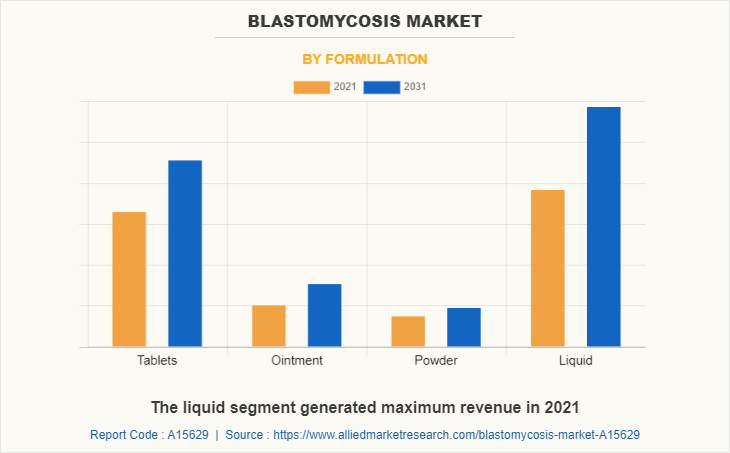
By Drug Type Segment Review
On the basis of drug type, the azoles segment generated maximum revenue in 2021, owing to a rise in the number of fungal infections such as blastomycosis, candidiasis, and immunological disease and a rise in awareness regarding the use of azole drug for the treatment of blastomycosis. The growth of the azoles segment is also associated with an increase in the use of azole drugs in combination with another drug for a synergistic effect.
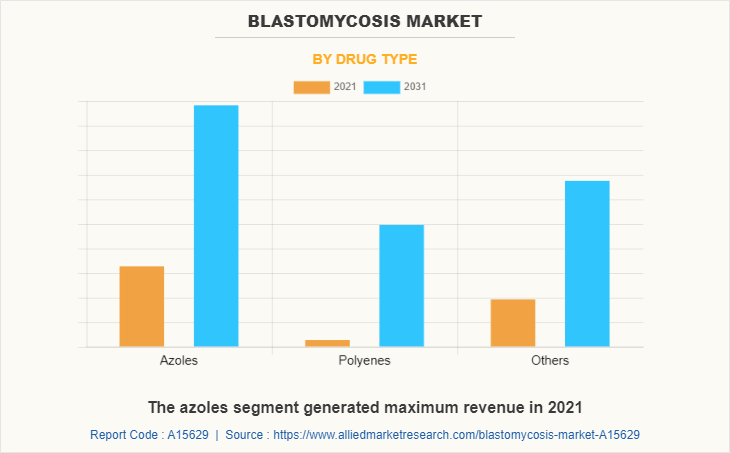
By Distribution Channel Segment Review
On the basis of distribution channel, the hospital and clinical pharmacy segment was the highest revenue contributor to the market in 2021, owing to an increase in demand for precise drugs according to the status of blastomycosis, and an increase in demand for consultation regarding the dosing of blastomycosis medicine.
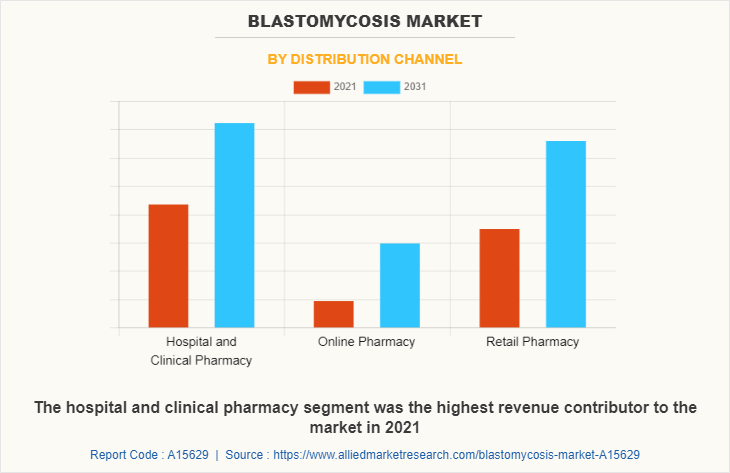
By Region Segment Review
By region, North America dominated the blastomycosis market in 2021, owing to the rise in the number of fungal infection cases, presence of key players advancement in healthcare in the region, robust healthcare infrastructure, presence of key players, and rise in healthcare expenditure.
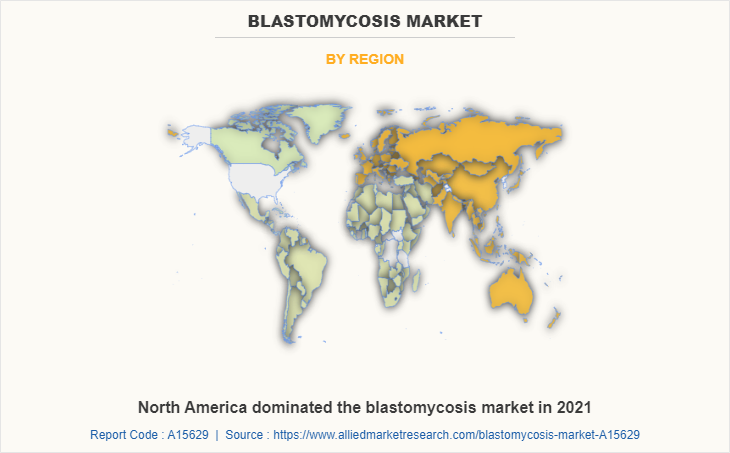
Some of the major companies that operate in the global blastomycosis market are Abbott Laboratories, Astellas Pharma Inc., Celon Laboratories Pvt.Ltd., Cipla Ltd, GlaxoSmithKline plc, Johnson and Johnson, Merck KGaA, Pfizer Inc., Sanofi S.A., and Sun Pharmaceutical Industries Ltd.
Key Benefits For Stakeholders
- This report provides a quantitative analysis of the market segments, current Blastomycosis Market Trends, estimations, and dynamics of the blastomycosis market analysis from 2021 to 2031 to identify the prevailing blastomycosis market opportunities.
- The Blastomycosis Industry research is offered along with information related to key drivers, restraints, and Blastomycosis Market Opportunity.
- Porter's five forces analysis highlights the potency of buyers and suppliers to enable stakeholders to make profit-oriented business decisions and strengthen their supplier-buyer network.
- An in-depth analysis of the blastomycosis market segmentation assists to determine the prevailing market opportunities.
- Major countries in each region are mapped according to their revenue contribution to the global market.
- Market player positioning facilitates benchmarking and provides a clear understanding of the present position of the market players.
- The report includes an analysis of the regional as well as global blastomycosis market trends, key players, market segments, application areas, and Blastomycosis Market Growth strategies.
Blastomycosis Market Report Highlights
| Aspects | Details |
| Market Size By 2031 | USD 257.7 million |
| Growth Rate | CAGR of 3.8% |
| Forecast period | 2021 - 2031 |
| Report Pages | 240 |
| By Drug Type |
|
| By Distribution Channel |
|
| By Formulation |
|
| By Region |
|
| Key Market Players | Sanofi, Sun Pharmaceuticals Ltd, Astellas Pharma Inc., Abbott Laboratories, GSK, johnson and johnson md&d, Merck and Company, CELON LABORATORIES LIMITED, Cipla Ltd, Pfizer Inc. |
Analyst Review
This section provides opinions of top level CXOs in the blastomycosis market. The blastomycosis market has witnessed growth, owing to high prevalence of fungal infection, improved diagnostics, and availability of new antifungals, which have revolutionized the field of medical mycology.
Moreover, the continuous R&D in the vaccines and antibody-based immunotherapy provides a steady growth to the pharmaceutical sector. In this regard, many key players have developed novel antifungal therapeutics that provide relief from varied antifungal infections. Dermal infections occur in high number and hence with advertisements and endorsements, many pharmaceutical companies promote several OTC drugs in the market to make public aware of the availability of treatments for dermal infections. These drugs are cost-effective and are available in various forms, such as powder, cream, solution, and others. As the topical antifungal drugs such as butenafine, clotrimazole, nitrate, hydrochloride, tolnaftate, and terbinafine are effective in the treatment of fungal skin infections, the coming years are expected to witness an exponential increase in the demand for antifungal medicines. The recent development of novel antifungal agents has significantly contributed to the treatment of blastomycosis successfully. Many antifungal drugs were outdated or of obsolete technology and patents were expired. However, increase in need for new, highly effective, and superior resistance anti-fungal technologies is the key factor that drives the market growth.
North America is expected to witness highest growth, in terms of revenue, owing to increase in cases of fungal infection, robust healthcare infrastructure, presence of key players, and in rise healthcare expenditure. However, LAMEA is anticipated to witness notable growth, owing to increase in awareness regarding use of combination of drugs against blastomycosis, unmet medical demands, and initiatives by government & non-governmental organization (NGO)s to promote awareness regarding use of anti-fungal medicine for the treatment of blastomycosis and increase in public–private investments in the healthcare sector.
New product launches are one of the key trends being observed in the blastomycosis market
The Azoles segment generated the maximum revenue in 2021
North America dominated the blastomycosis market in 2021
The blastomycosis market was valued at $177.16 million in 2021, and is estimated to reach $257.71 million by 2031, growing at a CAGR of 3.8% from 2022 to 2031.
Abbott, Astellas Pharma, and Cipla are a few major companies to occupy a major share of the Blastomycosis Market.
Growth in the population with antifungal drug resistance coupled with presence of counterfeit drugs restricts the growth of the Blastomycosis Market.
Yes
LAMEA is the fastest-growing region in the Blastomycosis Market
Loading Table Of Content...



